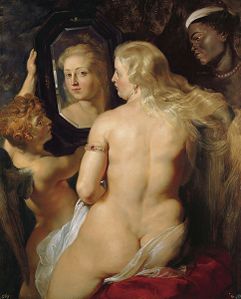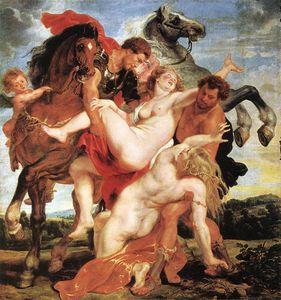Peter Paul Rubens
Sir Peter Paul Rubens (✦28 June 1577 – †30 May 1640) was a Flemish Baroque painter. A proponent of an extravagant Baroque style that emphasized movement, color, and sensuality, Rubens is well known for his Counter-Reformation altarpieces, portraits, landscapes, and history paintings of mythological and allegorical subjects.
In addition to running a large studio in Antwerp that produced paintings popular with nobility and art collectors throughout Europe, Rubens was a classically educated humanist scholar and diplomat who was knighted by both Philip IV of Spain and Charles I of England. Rubens was a prolific artist. The catalog of his works by Michael Jaffé lists 1,403 pieces, excluding numerous copies made in his workshop.
His commissioned works were mostly "history paintings", which included religious and mythological subjects, and hunt scenes. He painted portraits, especially of friends, and self-portraits, and in later life painted several landscapes. Rubens designed tapestries and prints, as well as his own house. He also oversaw the ephemeral decorations of the royal entry into Antwerp by the Cardinal-Infante Ferdinand in 1635.
His drawings are mostly extremely forceful but not overly detailed. He also made great use of oil sketches as preparatory studies. He was one of the last major artists to make consistent use of wooden panels as a support medium, even for very large works, but he used canvas as well, especially when the work needed to be sent a long distance. For altarpieces, he sometimes painted on slate to reduce reflection problems.
Links to Caravaggio
In 1600 Rubens traveled to Italy. The coloring and compositions of Veronese and Tintoretto had an immediate effect on Rubens's painting, and his later, mature style was profoundly influenced by Titian. With financial support from the Duke, Rubens traveled to Rome by way of Florence in 1601. There, he studied classical Greek and Roman art and copied works of the Italian masters. The Hellenistic sculpture Laocoön and his Sons was especially influential on him, as was the art of Michelangelo, Raphael, and Leonardo da Vinci. He was also influenced by the recent, highly naturalistic paintings by Caravaggio.
Rubens later made a copy of Caravaggio's "Entombment of Christ" and recommended his patron, the Duke of Mantua, to purchase "The Death of the Virgin". After he returned to Antwerp, he was instrumental in the acquisition of "The Madonna of the Rosary" for the St. Paul's Church in Antwerp. During this first stay in Rome, Rubens completed his first altarpiece commission, "St. Helena with the True Cross" for the Roman church of Santa Croce in Gerusalemme.
Art
- Paintings by Peter Paul Rubens
His nudes of various biblical and mythological women are especially well-known. Painted in the Baroque tradition of depicting women as soft-bodied, passive, and highly sexualized beings, his nudes emphasize the concepts of fertility, desire, physical beauty, temptation, and virtue. Skillfully rendered, these paintings of nude women were undoubtedly created to appeal to his largely male audience of patrons. Additionally, Rubens was quite fond of painting full-figured women, giving rise to terms like 'Rubensian' or 'Rubenesque' (sometimes 'Rubensesque'). And while the male gaze features heavily in Rubens's paintings of females generally, he brings multi-layered allegory and symbolism to his portraits. His large-scale cycle representing Marie de Medicis focuses on several classic female archetypes like the virgin, consort, wife, widow, and diplomatic regent. The inclusion of this iconography in his female portraits, along with his art depicting noblewomen of the day, serves to elevate his female portrait sitters to the status and importance of his male portrait sitters.
Rubens's depiction of males is equally stylized, replete with meaning, and quite the opposite of his female subjects. His male nudes represent highly athletic and large mythical or biblical men. Unlike his female nudes, most of his male nudes are depicted partially nude, with sashes, armor, or shadows shielding them from being completely unclothed. These men are twisting, reaching, bending, and grasping: all of which portrays his male subjects engaged in a great deal of physical, sometimes aggressive, action. The concepts Rubens artistically represents illustrate the male as powerful, capable, forceful, and compelling. The allegorical and symbolic subjects he painted reference the classic masculine tropes of male dominance, social superiority, war, and civil authority. Male archetypes readily found in Rubens's paintings include the hero, husband, father, civic leader, king, and the battle-weary.
Rubens was a great admirer of Leonardo da Vinci's work. Using an engraving done 50 years after Leonardo started his project on the Battle of Anghiari, Rubens did a masterly drawing of the Battle which is now in the Louvre in Paris. "The idea that an ancient copy of a lost artwork can be as important as the original is familiar to scholars," says Salvatore Settis, archaeologist and art historian.
Chat rooms • What links here • Copyright info • Contact information • Category:Root

